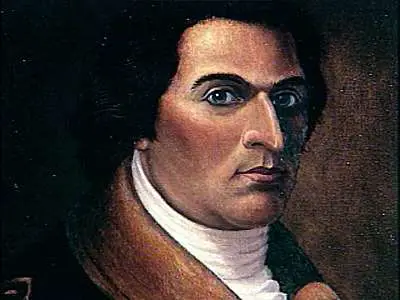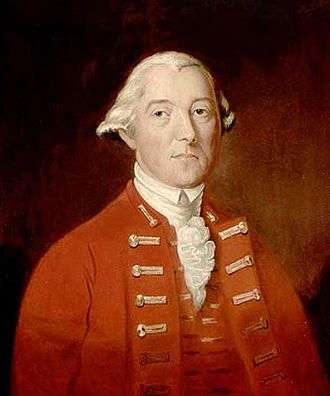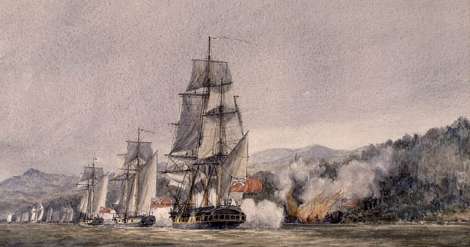In the fall of 1776, a scrappy little patriot navy stymied an invasion by overwhelming British military forces during the Battle of Valcour Island. Led by Benedict Arnold, a frantically built flotilla kept alive the revolution — and the new nation — in a daring military maneuver.
The British planned to crush the rebellion by cutting New England off from the Mid-Atlantic states. Their superior forces would sail down the corridor of lakes from Canada to Albany and then join the British in New York. Arnold, a former sea captain, proposed building a fleet to guard that vital link. He wanted vessels that could maneuver better in Champlain’s shallow waters than the deepwater British warships.
Arnold’s Exploits
Arnold had spent the first year of the American Revolution harassing the British. In concert with Vermonter Ethan Allen, Arnold successfully took Fort Ticonderoga in May of 1775. Henry Knox then brought the artillery from Ticonderoga to Boston and in March George Washington used it to force British troops to evacuate.

Benedict Arnold
Meanwhile, Arnold launched an attack on Quebec, which failed dramatically and left him with a wounded leg. Arnold retreated down Lake Champlain after his unsuccessful siege of Quebec City on New Year’s Eve, 1775.
By the spring of 1776, the battered American forces had hunkered down at Fort Ticonderoga and Crown Point. Smallpox struck and killed a staggering number of soldiers. John Adams, in a letter to Abigail, described the army at Crown Point as “an Object of Wretchedness, enough to fill a humane Mind, with Horror…”
A Race To Build Ships
Over the summer of 1776, the British amassed a force of some 10,000 troops. But they needed warships to carry them down the lake. The patriot forces had, during their retreat from Quebec, destroyed any vessel that could prove useful to the British.
And though the Americans were badly overmatched, they had seized British gunboats when they captured Ticonderoga.
So British Gen. Guy Carleton, stationed in Saint-Jean at the northern end of the lake, requisitioned and received disassembled warships. Expert British shipwrights reassembled the ships to give Britain a navy on Champlain that included 25 fighting ships and scores of support vessels.

Guy Carleton
Meanwhile, the Americans raced to build their own fleet. Beginning on July 10, Arnold began overseeing construction. He was no longer in his native New Haven, but in upstate New York, nowhere near ship fittings, marine carpenters or experienced sailors. In a frenzy of activity, he requisitioned artisans, organized carpenters, personally selected lumber from local sawmills and supervised the shipment of lead.
Mismatch
The British fleet, when finished, consisted of 20 gunships and five sailing vessels. One was the largest ever to sail on Lake Champlain. The fleet also had 50 support vessels. The British Royal Navy’s most experienced commanders and sailors staffed the vessels. They also carried 1,300 pounds of cannonball, nearly twice as much as the Americans’ 703 pounds.
The American fleet included a sloop, schooners, galleys and flat-bottomed gundalows, large rowboats with sails. Arnold chose as his flagship a captured British schooner, the Royal Savage.
Arnold sailed his little fleet north in September, patrolling the lake. Then on September 23, he moved his fleet to Valcour Island, a spot he had chosen carefully to nullify the British advantage in firepower. The British vessels could only attack one at a time in the rocky channel between the island and shore.
Arnold even camouflaged his boats. He had them painted red to match the autumn leaves and the bulwarks covered in brush.

Arnold stationed his fleet inside the red square.
The Battle of Valcour Island
Gates’ had given Arnold specific orders: “Should the enemy come up the lake and attempt to force their way through the pass you are stationed to defend, in that case you will act with such cool, determined valor as will give them reason to repent their temerity.” Arnold was to keep the British bottled up in Canada until winter, where they would stay until spring.
The British fleet appeared off Valcour Island on the morning of October 11. Arnold sent two vessels out to lure them toward the channel where his fleet lay in wait. At 11 a.m. the fight started — badly for the Americans. The Royal Savage ran aground and the British captured her.
The British pounded the Americans. Arnold’s fleet had played a cat-and-mouse game, ducking into shallower waters to avoid the British fire and emerging to fire broadsides and cannonades at the enemy.
At sunset, the British withdrew to a line south of Valcour Island, blocking the American way out of the channel. Carleton figured they’d finish the job in the morning. Some British ships had literally run out of ammunition in battering the Americans.

Painting of the Battle of Valcour Island from the Canadian National Archives
Arnold’s fleet had taken a terrific pounding. The British killed or wounded 80 and captured 20, one-fifth of the men. The ships were badly damaged. The Americans used up three-quarters of their ammunition. And the British would complete their destruction at sunrise.
Escape
Arnold had a plan both desperate and risky, but with a chance of success. He ordered his men to retreat by slipping between the British ships.
With muffled oars and no lights – and the assistance of a moonless night heavy fog – Arnold’s leaky and battered fleet sneaked south to Crown Point.
Carleton woke up the next morning shocked and furious to find Arnold had dodged a final crushing defeat. Thinking the Americans were hiding somewhere at Valcour Island, he sent ships to search for them.
Then, intuiting what had happened, the British sailed south. With the British fleet bearing down, Arnold began destroying the American ships. The British captured one ship along with 110 men – roughly one-fifth of the American force. Arnold drove the remaining ships onto the rocks and left them in flames, their American flags still flying.
Too Late
As the British secured the area, it began snowing. They concluded that the season was too late to press forward toward Boston. They would winter over in the area preparing for the spring, which set up the Battle of Saratoga in 1777. There, Arnold would achieve his last triumph on behalf of America.
The Battle of Valcour Island typified Arnold’s wartime caareer. His fleet successfully slowed the British advance to give the patriot cause time to grow. But in the flight he had lost many of his records. That ultimately prevented him from winning reimbursement for the money he spent on behalf of the military during his expeditions.
The retreat and loss of the fleet also gave Arnold’s political enemies fodder to use against him. Some even suggested he’d made a mistake by losing the fleet while delaying the advance of the British.
Arnold’s Enemies
Pennsylvania Governor Joseph Reed, Arnold’s chief critic, and Benedict Arnold were in many ways complete opposites, though both were patriots.
Arnold had made his way in New Haven, Conn., in the rough-and-tumble world of trading. Reed was a Philadelphia lawyer.
Arnold served as George Washington’s battlefield general. Reed was a politician and member of Congress. Reed was famously scrupulous with a keen dislike for any taint of corruption. He had no use for anyone with affection for loyalists.
Arnold bent rules to keep his dwindling fortune from being snuffed out completely by the cost of financing the war. And he married a young loyalist wife in Philadelphia. Arnold was shot twice in fighting the Revolutionary War. Reed was never injured in battle; he designed a flag for the navy.

Joseph Reed
Arnold would accuse Reed and his like of refusing to reimburse the costs of war and pushing the promotion of politically connected officers ahead of better-qualified soldiers in the military. Reed would accuse of Arnold of putting his business interests ahead of the revolutionary cause.
Would the American Revolution have succeeded if Arnold and his men had not delayed the British advance, first at Valcour Island and later at Saratoga? Would Arnold have still turned traitor if not for Reed and his supporters badgering him over his bills. Or would Arnold have been lead to support the British anyway, under influence of his young loyalist wife?
And what’s the best way to balance the power of political leaders and military leaders? It makes a good debate.
With thanks to Valcour: The 1776 Campaign That Saved the Cause of Liberty by Jack Kelly. This story was updated in 2023.
